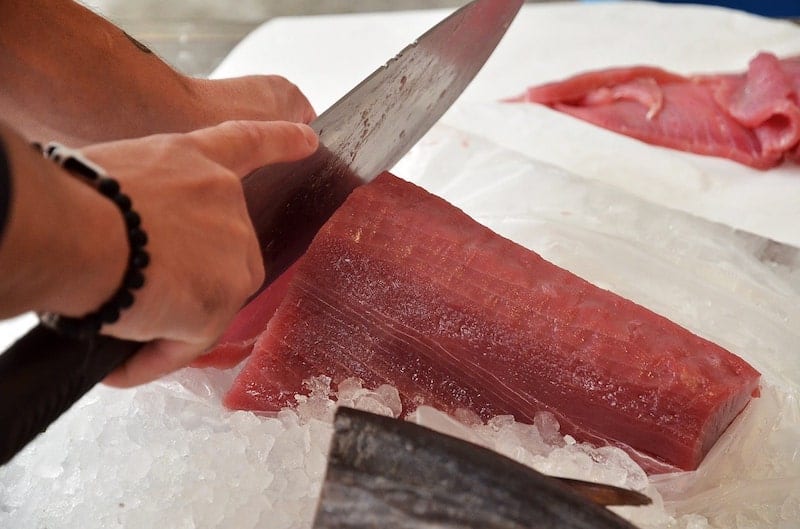How to Store Sushi Grade Fish
Sushi has become so popular that more people are now making it at home. Still, you’re consuming raw fish in sushi, so some caution is advised to stop bacteria from developing.
However, as long as you know how to store sushi grade fish at home, there’s no reason why you can’t have fun with sushi recipes. In this article, I’ll tell you everything you need to know about how to manage sushi-grade fish.
Now, the official recommendation here is that sushi grade fish should not be stored at all. It should be prepared and eaten right when you bring it home. That said, of course, the fridge is always an option, for up to two days that is, although this is already pushing the limit. Read on to learn more.
How Do You Properly Store Sushi-Grade Fish to Eat Later?
Generally speaking, you really don’t want to store sushi grade fish at all. Sushi grade fish should be used immediately after purchasing.
In other words, you should buy it, take it home, make sushi with it (it actually doesn’t take too long to make), and eat it.
With that being said, it is possible to store sushi grade fish in the fridge. However, there’s only so much that a fridge can do for sushi grade fish, and for the most part, it won’t last more than two days – even in the refrigerator.
Yes, you can also try putting it in Tupperware or in plastic wrap, although this will really just stop it from drying out but won’t actually stop it from going bad. A Tupperware container might buy you an extra few hours, but that’s about it.
In terms of freezing sushi grade fish, although it definitely doesn’t do you any favors in terms of texture and taste, it will preserve it for about a week, give or take.
Remember, it does also depend on exactly how fresh the fish was when you bought it before freezing it.
Do remember to use special bags or containers designed specifically for keeping food fresh in the freezer.
On this topic, for more information on how to properly store sushi rice, check out my article here.
How Long Does Sushi Grade Fish Last in the Fridge?
If you do not prepare your fresh sushi-grade fish right away, you’re taking a risk that it might go bad.
It’s not easy to predict how long your fish can sit in the fridge before you can’t use it anymore. It’ll depend on how fresh it was when you bought it and how long it took you to bring it home – among other things.
However, on average, you can expect one to a maximum of two days for your fish to remain fresh. After that, you should place it in a clean airtight container and ensure no excess liquid is present to promote bacteria growth. Make sure your fridge is at a solid 41° Fahrenheit.
How Can You Tell if Sushi-Grade Fish Has Gone Bad?
When it comes to sushi-grade fish, your sense of smell will be your best guide. If you take your fish from the fridge and it smells – well, like a fish, then it’s too late to eat it.
Typically, you have a window of 24 hours of freshness if adequately stored in the fridge, and beyond that, you’re putting your health in danger by eating the fish.
You might have a more challenging time discerning if the fish has gone bad if it’s already been made into sushi or sashimi.
While you may not smell the difference in freshness, you can look for other clues, like limp seaweed paper.
The same applies to the color of the sushi. If it’s a bit dull and different from when you bought it, do yourself a favor and throw it out.
How Long Can You Keep Sushi-Grade Fish Frozen?
As we established, the best way how to store sushi-grade fish is to freeze it first. In most cases, the sushi you eat at restaurants is made from previously frozen seafood.
If you’ve bought the perfect sushi-grade fish and want to eat it much later, you need to freeze it at -4° F for at least one week. On the other hand, if you’re in a hurry and want to eat sushi-grade fish in the safest possible manner, you can freeze it for about 15 hours at -31° F.
If you maintain optimal temperatures throughout, you can even keep the frozen fish for years. However, there are differences when it comes to what type of fish should be frozen.
What Is the Best Sushi Grade Fish?
When you’re getting started with homemade sushi recipes, it’s crucial to understand that not all fish is equally susceptible to parasites. It’s best to get started with raw fish that’s considered safest to use.
Tuna
At the very top of the list sits tuna. It’s even the type of raw fish that often doesn’t require any freezing to be considered safe.
It generally needs very little processing because it’s incredibly resistant to parasites. That goes for yellowfin tuna, bluefin, skipjack, bigeye, albacore, and bonito.
Salmon
It’s undoubtedly a favorite among sashimi enthusiasts. While it may seem counterintuitive, the farmed salmon is better than its wild-caught cousin when it comes to eating it raw. Freshwater brings more risk of parasites, whereas farmed salmon is generally safer.
Mackerel
The only issue with mackerel is that it can be high in mercury. That’s why it’s treated with vinegar before serving. But, in terms of safety, it’s one of the best sushi-grade fish to try.
Yellowtail
Many people prefer yellowtail as it’s very high in protein and omega 3-fatty acids. It’s also incredibly tasty and one of the safest choices for sushi-grade fish.
In Summary
The most important thing to remember about storing sushi-grade fish is that freezing is the best way to go.
We already know that frozen fruits and vegetables are equally nutritious as raw. With sushi-grade fish, the situation is even better as the process removes all parasites.
If you want to store the fish in the fridge, though, make sure not to leave it in more than a day or two. Also, before eating it, always test its freshness.








